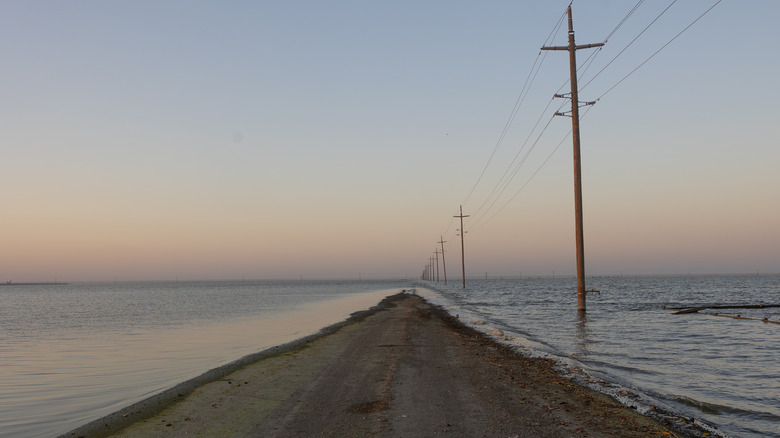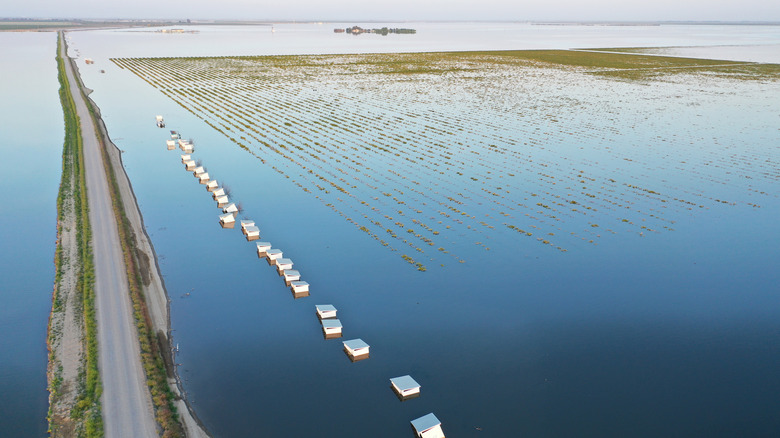Why A Massive California Lake Keeps Disappearing For Decades At A Time
In the heart of California's San Joaquin Valley, just east of Interstate 5, there is a vast depression in the Earth that stretches for miles. It's hard to notice as you drive by; the land is filled up by farms growing nut trees, cotton, safflower, tomatoes, wheat, and many other crops that help make the Central Valley an agricultural powerhouse. The soil is rich and the sun shines nearly every day, but it is also very hot and very dry. That's what made it so shocking when, in 2023, that whole vast depression transformed into a massive lake.
The lake was not new to the area; in fact, it was quite the opposite. Over a century before, the land was covered by a body of water known as Tulare Lake (too-LAIR-ee). It stretched across an area of over 800 square miles, and until the 1800s, it was the largest freshwater lake east of the Mississippi. Then, over the course of just a few decades, an aggressive expansion of agriculture across the valley turned the lake into a dry shell of itself.
Tulare Lake lived on in history books, but in the spring of 2023, it came to life again. The lake's rebirth was the result of a series of extreme weather events called atmospheric rivers, which inundated the land with rainfall, flooding the basin. A year later, it was all gone. The waters receded and the lake ran dry again. Someday though, it will come back.
The troubling history of Tulare Lake
It looks nothing like it now, but the San Joaquin Valley was once a massive floodplain defined by marshlands and rivers. These rivers were fed by snowmelt running down from the Sierra Nevada mountain range, and because the valley offers no outlet to the ocean, all the water ended up pooling in the center of the basin, forming a lake. The tule reeds that grew throughout the wetlands were the source for the name, Tulare Lake.
The lake has always held particular significance to the indigenous Tachi Yokut Tribe, who call it "Pa'ashi," meaning "big water." Pa'ashi provided food, and its waterways served as intertribal trade routes. However, after the United States annexed present-day California through the Treaty of Guadalupe Hidalgo at the end of the Mexican-American War, settlers descended upon the land, and began a radical makeover of the area. In a "land reclamation" effort, agriculturalists built dams and canals to take control of the valley's waterways and use them to irrigate farmland.
The settlers achieved their goal. The Central Valley now provides a quarter of the nation's food supply, pumping billions of dollars into the economy. But human impact on the environment is, unfortunately, typically for the worst. Diverting the Sierra Nevada runoff robbed Tulare Lake of its source. By 1890, it was gone, and farmers quickly filled the space with cropland. As they did, the Tachi Yokut were forced out of their homes, the source of their livelihood lost.
Tulare Lake has returned before, and will again
The massive flooding that revived Tulare Lake in 2023 was not a one-off occurrence. There have been four other occasions where unusually heavy rains have filled the lake basin, the first two coming in the 1930s. Another came in the 1960s, and again in 1983, a year in which over 80,000 acres of farmland flooded. This level of flooding was ultimately surpassed in 2023, when Tulare Lake returned to cover over 100,000 acres.
The return of the lake was a nightmare for local farmers. Orchards and fields were drowned, causing hundreds of millions of dollars in crop losses. The 22,000-person town of Corcoran, situated at the basin's edge, experienced widespread floods after the rising waters breached levees and canals. In response, California officials declared a state of emergency, building flood retainers and reconstructing the levee around Corcoran. The floodwaters were drained again and stored in reservoirs and aquifers for future irrigation needs.
For others, the resurgence of Tulare Lake was a gift. Hundreds of thousands of waterfowl, migrating over the land along the Pacific Flyway, found a welcome pitstop on its shores. Egrets, ibises, sandpipers, stilts, and blackbirds were able to return to the lake that their ancestors had visited centuries before. The tule reeds that gave their name to the lake sprouted in abundance. They're gone now, leaving along with the waters, but they will be back. With California experiencing an increasing number of severe weather events, Tulare Lake probably won't be gone for long.


